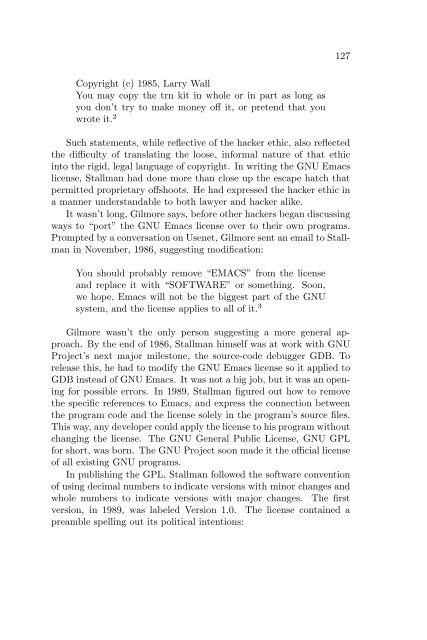You also want an ePaper? Increase the reach of your titles
YUMPU automatically turns print PDFs into web optimized ePapers that Google loves.
Copyright (c) 1985, Larry Wall<br />
You may copy the trn kit in whole or in part as long as<br />
you don’t try to make money off it, or pretend that you<br />
wrote it. 2<br />
127<br />
Such statements, while reflective of the hacker ethic, also reflected<br />
the difficulty of translating the loose, informal nature of that ethic<br />
into the rigid, legal language of copyright. In writing the GNU Emacs<br />
license, Stallman had done more than close up the escape hatch that<br />
permitted proprietary offshoots. He had expressed the hacker ethic in<br />
a manner understandable to both lawyer and hacker alike.<br />
It wasn’t long, Gilmore says, before other hackers began discussing<br />
ways to “port” the GNU Emacs license over to their own programs.<br />
Prompted by a conversation on Usenet, Gilmore sent an email to Stallman<br />
in November, 1986, suggesting modification:<br />
You should probably remove “EMACS” from the license<br />
and replace it with “SOFTWARE” or something. Soon,<br />
we hope, Emacs will not be the biggest part of the GNU<br />
system, and the license applies to all of it. 3<br />
Gilmore wasn’t the only person suggesting a more general approach.<br />
By the end of 1986, Stallman himself was at work with GNU<br />
Project’s next major milestone, the source-code debugger GDB. To<br />
release this, he had to modify the GNU Emacs license so it applied to<br />
GDB instead of GNU Emacs. It was not a big job, but it was an opening<br />
for possible errors. In 1989, Stallman figured out how to remove<br />
the specific references to Emacs, and express the connection between<br />
the program code and the license solely in the program’s source files.<br />
This way, any developer could apply the license to his program without<br />
changing the license. The GNU General Public License, GNU GPL<br />
for short, was born. The GNU Project soon made it the official license<br />
of all existing GNU programs.<br />
In publishing the GPL, Stallman followed the software convention<br />
of using decimal numbers to indicate versions with minor changes and<br />
whole numbers to indicate versions with major changes. The first<br />
version, in 1989, was labeled Version 1.0. The license contained a<br />
preamble spelling out its political intentions:


